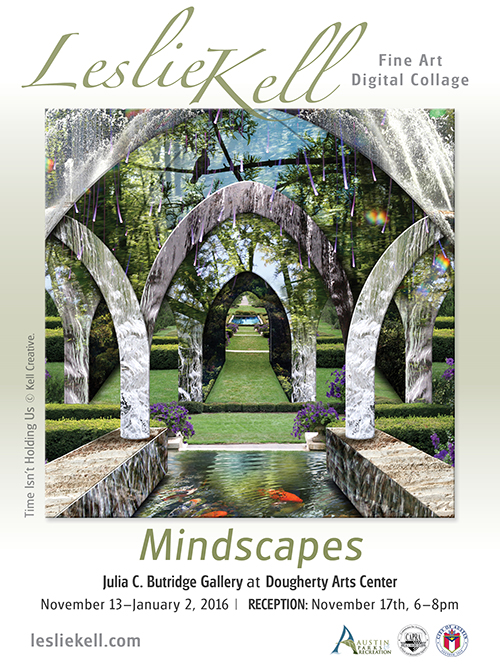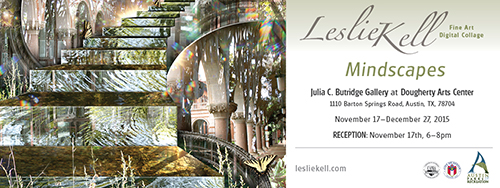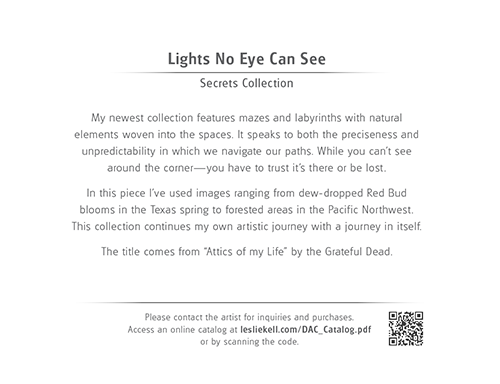by Carolyn Edlund
Austin, Texas-based artist Leslie Kell takes a professional approach to promoting her work. Her marketing plan is impressive, and provides some great examples for other artists.

In situ photo of Leslie Kell’s artwork
Leslie Kell’s portfolio is filled with digital photo collages using a technique that she has developed over the past eight years. Much of her work is architectural in nature, with photos and patterns layered and manipulated. Reflections, highlights, contours and textures fill the complex imagery that she creates in 2D as well as 3D installations of her work. Almost every piece also includes a “winged soul” such as a bird or butterfly, taking flight across a virtual sky, as a small reminder of the fragility of the moment.
She explains, “I once heard a juror say: ‘There is no substitute for the physical encounter.’ I’d like to think that my artwork is a physical, even spiritual encounter. I hope to achieve a sense of wonder, movement and maybe even a whisper of sound.”

Leslie Kell “Mindscapes” exhibition
Since her work needs to be seen and experienced, and photographic images are the only way that she can share her art with people who are not physically present, she came up with a number of ideas to appeal to and draw in prospective collectors. Her efforts have paid off; a recent gallery show of her work at the Dougherty Arts Center opened to a large crowd responding to her invitation, and ready to buy.
Before she began the marketing for this event, she created two things – a digital media kit on her website, and a catalog for her upcoming Mindscapes gallery show. Both are in pdf format, ready for downloading.
For her media kit, Kell wanted to appeal to the press visually as well as with plenty of written information about her work. This provided a rich selection to choose from – a reporter or blogger could easily write about her even if they never got the chance to personally speak with her.
What made her want to make a digital media kit? “I’ve always had a pdf of my portfolio to send out on request or for submissions, so it seemed natural to make it available for download,” she says. “I loved the idea of making the information available to anyone, including press, all in one place. I had considered doing a brochure, but this is so much more comprehensive.”
She organized her press kit to include the following information:
- Upcoming shows
- Artist statement
- Bio
- CV
- Past press and reviews
- Honors and awards
- Specialty work: custom, public
- FAQs
- Contact info (links are live in the pdf once downloaded and opened in Acrobat)

Promotional image for Leslie Kell’s exhibition
Kell’s second project was making a downloadable catalog for the Mindscapes exhibition. I asked her about the reasoning for this. She responds, “It works in a few ways. First, by ‘unveiling’ a preview of the show to my mailing list, it offers a bit of insider treatment to my contacts and hopefully creates some interest. Also, the catalog exposes the work to people who don’t come to the physical space. And, whether they make it to the show or not, they can share it with those who may not be able to visit in person.”
Having designed the pdf, she can easily make ongoing changes to it – to mark items sold, for instance. And, to further promote the downloadable catalog, she tried something new on the wall cards that accompany each piece of work in the show. At the bottom of the description, she added a QR code and URL that link to the catalog – so visitors could review, revisit and share.

Example of wall card with QR code leading to downloadable exhibit catalog
Kell shares the link on her website homepage and in the exhibit listing as well. This makes the exhibit accessible beyond the physical encounter.
I asked her for recommendations on what other artists can do to create their own digital catalogs, press kits and more. She responds, “I have been a graphic designer for most of my life, so I came to the project with a fairly specialized skill set. But fear not, there are multitudes of ways to pull this together. There are online design templates that can be customized to create stunning presentations. I would start with a brochure or annual report template.”
“There is software and even apps that tend to be user-friendly and can be saved in a format that can be posted or emailed,” she adds. “You may know a designer or a tech savvy teenager that might be able to help you out for a piece of art in trade, pizza or a fee. Think of it as a visual resume and take it one step at a time. This is a process that will take longer than an afternoon and will need to be kept up to date. In the meantime, document everything so you have a wealth of material to use when the time comes. Now is not the time to be shy.”
In addition to creating a media kit and catalog, she used lots of email marketing and social media strategies to promote as well – and we’ll be covering those in “Serious About Art Marketing – Part 2.”



It’s another great strategy for marketing and appears to be something most artists can do themselves with some dedicated time and a willingness to learn. The first thing that came to mind is whether the images have copyright overlays and after visiting the catalog it appears it does not. I may have missed them I suppose if they were subtle but the obvious risk is someone stealing the images, and printing themselves. Is this a concern for others? How do you counter the potential for theft without ruining the experience for your copyright respecting viewers?
Thank you for sharing another great marketing strategy.
Rhoda J Powers
I understand the concern many artists have. In this case, I don’t worry too much about it since the images are low resolution and any reproduction would be sub-standard quality. I watermark my images on my web site, so if they are pinned or shared online my name travels with them and they can be tracked back to me if desired. I probably should consider the same treatment across the board, but I find it disrupts the image more than I would like on the portfolio presentation. Thanks for your thoughtful question.
Thank you so much for sharing your marketing process. As an “emerging” artist there are so many aspects to consider that it gets overwhelming at times. I will be saving this for future reference.
Great ideas to put into a press kit for future reference as to what topics I should include in mine, thank-you for sharing your tips with all of us.
I agree Linda – Leslie’s ideas really set the stage for getting good press. And, she is getting press through this article as one result!